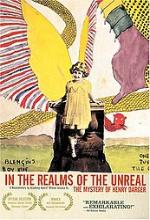

Knight at the Movies ARCHIVES

Loners:
In the Realms of the Unreal, Superstar in a Housedress
1-19-05 Knight at the Movies column
By Richard Knight, Jr.
Soon before his 81st birthday in 1973, Chicagoan Henry Darger, who had no family and no close friends, was
forced by ill health to move to a Catholic hospital from his Lincoln Park apartment. Upon entering the one room
where Darger had lived for over 40 years, his landlords Nathan and Kiyoko Lerner discovered that he’d exactingly
created a fantasy world via 300 paintings and a 15,000-page novel. Darger, who worked by day as a janitor, had
for decades been nightly inventing the alternate universe of the Vivian Girls, seven angelic sisters who lead a
rebellion against godless, child-enslaving men.
Upon Darger’s death not long after, the Lerners decided to leave his apartment intact and share his artwork with
the world. Since then Darger has been the subject of numerous exhibitions and has become the most famous of
outsider, or self-taught, artists. Now director Jessica Yu has crafted a documentary that takes its title from
Darger's world. In The Realms of the Unreal is both a fascinating biography and a mystery story without
a solution. How could this portrait of a dead man who left no relatives, had no real friends and spent all his free
time secretly creating a fantasy world be anything else?
Yu’s captivating account draws on the self-history that Darger left behind and she was able to photograph the
apartment before it was dismantled in 2000. Both these offer tangible clues into what made Darger tick and the
film also makes obvious connections between Darger’s terrible Dickensian childhood and his mythical creation. But
Yu, one artist observing another, perhaps, doesn’t presume to offer any real psychological evaluation of Darger’s
personality or motivations. For example, Darger often drew the sisters naked and with penises but who can say
why? Neighbors and co-workers, who barely noticed Darger when he was alive, suggest innocence about sex as
one possible reason but though Yu undertook years of research into Darger’s work, she doesn’t really seem
interested in hypothetical answers and the film is stronger and much more tantalizing because she allows Darger’s
work to speak for itself.
As excerpts from Darger’s book are read and the paintings are crudely animated, aping the style of the pictures
(which are reminiscent of Op artist Peter Max’s work), many other questions came to mind but are left unasked.
Why did Darger only fixate on little girls? What happened to Darger’s long lost sister? Why was the apartment
dismantled? Did Darger ever speak of his work or show it to anyone during the decades that he worked on it? Did
he suffer from a mental illness like Avoidant Personality Disorder?
Yu cannily has the movie narrated by child actress Dakota Fanning which adds another level of creepy fascination
– especially when pictures of the little girls being tied up, disemboweled or frolicking as dragons fly overhead are
shown. Darger’s lifelong struggle with Catholicism (there are distinct similarities between C.S. Lewis’ Narnia and
the Realms), his early attempts to adopt a child, his teenage friendship with another man (who seems to have been
his only friend) are just more interesting components of the mystery.
Darger had no TV or radio, slept in a chair, and was too poor to afford to keep a pet. “I never had a good
Christmas or even a good New Year’s all my life,” he says in a voice over as portrayed by actor Larry Pine but
apparently the power of his imagination and the need to create kept him going. Always, we are told, “he wanted
the quiet rapture again” referring to his boyhood days of innocence that seem to have become inextricably tied to
his fantasy world. Toward the end of the film, after the Lerner’s had discovered the work, one of Darger’s
neighbors visited him in the hospital and shyly told him that he’d seen the paintings. Darger’s eyes widened in
shock and then he sadly said, “Too late now.”
Yu’s film, which details the triumph of an everyday man’s imagination over his bland reality, is a fitting epitaph that
might have surprised and delighted the secretive, creative subject it seeks to portray though, that too, we’ll never
know. If nothing else, the film certainly makes a persuasive argument for a creative retreat, a “quiet rapture” of
one’s own.
+++++++++++++++++++++++++++++++++++++++++++++++++++++++++++++++
Flamboyant transvestite Warhol superstar Jackie Curtis is featured in another fascinating documentary also
opening this week. Though we are told repeatedly throughout the first half of Superstar in a Housedress
that Curtis was a brilliant performer who was outrageous both on and offstage, it’s the group of comrades that
reminisce about him that hold the attention. Seeming like a collection of folks from either a Fellini or Almodóvar
film, this disparate group chat on and on about how Curtis ripped up designer clothes, had terribly witty things to
say, doodled on the walls of friend’s homes and helped himself to drugs, liquor and whatever else he could get his
hands on because “he couldn’t help it.” But they’re a really fun bunch of New York “love me” types – though
obviously many have seen their heyday come and go – and the interiors of their collected apartments are at times
more interesting than their stories of Curtis writing the first drag queen parody musical or whatever it was.
Then, at the midpoint, we begin to see old videotapes of Curtis in action and finally get a sense of his genius – his
blurring of all sexual borders and obvious influence on everything from the Dr. Frank N. Furter character in “Rocky
Horror,” David Bowie’s Ziggy Stardust and more recent drag superstars like Charles Busch and Joey Arias. This
entertaining, diverting documentary, narrated by Lily Tomlin, with its audacious cast, ends with the details of the
bizarre circumstances surrounding Curtis’s drug overdose at 38 in 1985 (he died in bed after having sex for the
first time with a woman) and subsequent, outrageous funeral. That such circumstances, 20 years after his death,
can still provoke shock, amusement and sadness among his friends and audiences who knew nothing of Curtis
would certainly have pleased such an outré persona.
In the Realms of the Unreal, Superstar in a Housedress
1-19-05 Knight at the Movies column
By Richard Knight, Jr.
Soon before his 81st birthday in 1973, Chicagoan Henry Darger, who had no family and no close friends, was
forced by ill health to move to a Catholic hospital from his Lincoln Park apartment. Upon entering the one room
where Darger had lived for over 40 years, his landlords Nathan and Kiyoko Lerner discovered that he’d exactingly
created a fantasy world via 300 paintings and a 15,000-page novel. Darger, who worked by day as a janitor, had
for decades been nightly inventing the alternate universe of the Vivian Girls, seven angelic sisters who lead a
rebellion against godless, child-enslaving men.
Upon Darger’s death not long after, the Lerners decided to leave his apartment intact and share his artwork with
the world. Since then Darger has been the subject of numerous exhibitions and has become the most famous of
outsider, or self-taught, artists. Now director Jessica Yu has crafted a documentary that takes its title from
Darger's world. In The Realms of the Unreal is both a fascinating biography and a mystery story without
a solution. How could this portrait of a dead man who left no relatives, had no real friends and spent all his free
time secretly creating a fantasy world be anything else?
Yu’s captivating account draws on the self-history that Darger left behind and she was able to photograph the
apartment before it was dismantled in 2000. Both these offer tangible clues into what made Darger tick and the
film also makes obvious connections between Darger’s terrible Dickensian childhood and his mythical creation. But
Yu, one artist observing another, perhaps, doesn’t presume to offer any real psychological evaluation of Darger’s
personality or motivations. For example, Darger often drew the sisters naked and with penises but who can say
why? Neighbors and co-workers, who barely noticed Darger when he was alive, suggest innocence about sex as
one possible reason but though Yu undertook years of research into Darger’s work, she doesn’t really seem
interested in hypothetical answers and the film is stronger and much more tantalizing because she allows Darger’s
work to speak for itself.
As excerpts from Darger’s book are read and the paintings are crudely animated, aping the style of the pictures
(which are reminiscent of Op artist Peter Max’s work), many other questions came to mind but are left unasked.
Why did Darger only fixate on little girls? What happened to Darger’s long lost sister? Why was the apartment
dismantled? Did Darger ever speak of his work or show it to anyone during the decades that he worked on it? Did
he suffer from a mental illness like Avoidant Personality Disorder?
Yu cannily has the movie narrated by child actress Dakota Fanning which adds another level of creepy fascination
– especially when pictures of the little girls being tied up, disemboweled or frolicking as dragons fly overhead are
shown. Darger’s lifelong struggle with Catholicism (there are distinct similarities between C.S. Lewis’ Narnia and
the Realms), his early attempts to adopt a child, his teenage friendship with another man (who seems to have been
his only friend) are just more interesting components of the mystery.
Darger had no TV or radio, slept in a chair, and was too poor to afford to keep a pet. “I never had a good
Christmas or even a good New Year’s all my life,” he says in a voice over as portrayed by actor Larry Pine but
apparently the power of his imagination and the need to create kept him going. Always, we are told, “he wanted
the quiet rapture again” referring to his boyhood days of innocence that seem to have become inextricably tied to
his fantasy world. Toward the end of the film, after the Lerner’s had discovered the work, one of Darger’s
neighbors visited him in the hospital and shyly told him that he’d seen the paintings. Darger’s eyes widened in
shock and then he sadly said, “Too late now.”
Yu’s film, which details the triumph of an everyday man’s imagination over his bland reality, is a fitting epitaph that
might have surprised and delighted the secretive, creative subject it seeks to portray though, that too, we’ll never
know. If nothing else, the film certainly makes a persuasive argument for a creative retreat, a “quiet rapture” of
one’s own.
+++++++++++++++++++++++++++++++++++++++++++++++++++++++++++++++
Flamboyant transvestite Warhol superstar Jackie Curtis is featured in another fascinating documentary also
opening this week. Though we are told repeatedly throughout the first half of Superstar in a Housedress
that Curtis was a brilliant performer who was outrageous both on and offstage, it’s the group of comrades that
reminisce about him that hold the attention. Seeming like a collection of folks from either a Fellini or Almodóvar
film, this disparate group chat on and on about how Curtis ripped up designer clothes, had terribly witty things to
say, doodled on the walls of friend’s homes and helped himself to drugs, liquor and whatever else he could get his
hands on because “he couldn’t help it.” But they’re a really fun bunch of New York “love me” types – though
obviously many have seen their heyday come and go – and the interiors of their collected apartments are at times
more interesting than their stories of Curtis writing the first drag queen parody musical or whatever it was.
Then, at the midpoint, we begin to see old videotapes of Curtis in action and finally get a sense of his genius – his
blurring of all sexual borders and obvious influence on everything from the Dr. Frank N. Furter character in “Rocky
Horror,” David Bowie’s Ziggy Stardust and more recent drag superstars like Charles Busch and Joey Arias. This
entertaining, diverting documentary, narrated by Lily Tomlin, with its audacious cast, ends with the details of the
bizarre circumstances surrounding Curtis’s drug overdose at 38 in 1985 (he died in bed after having sex for the
first time with a woman) and subsequent, outrageous funeral. That such circumstances, 20 years after his death,
can still provoke shock, amusement and sadness among his friends and audiences who knew nothing of Curtis
would certainly have pleased such an outré persona.
The Urge to Create is VERY Strong

